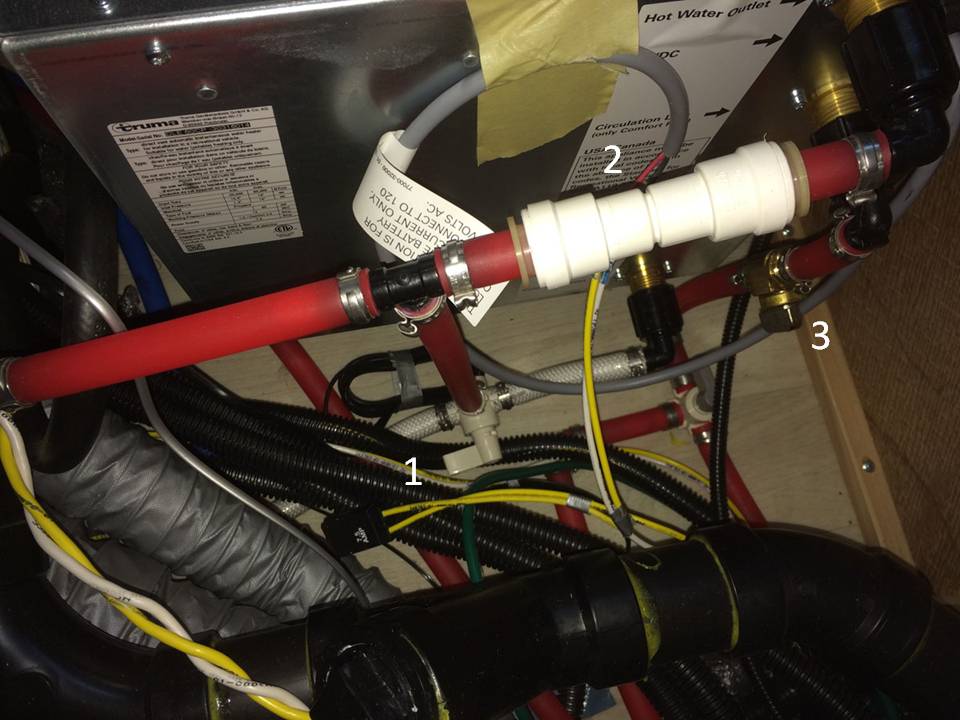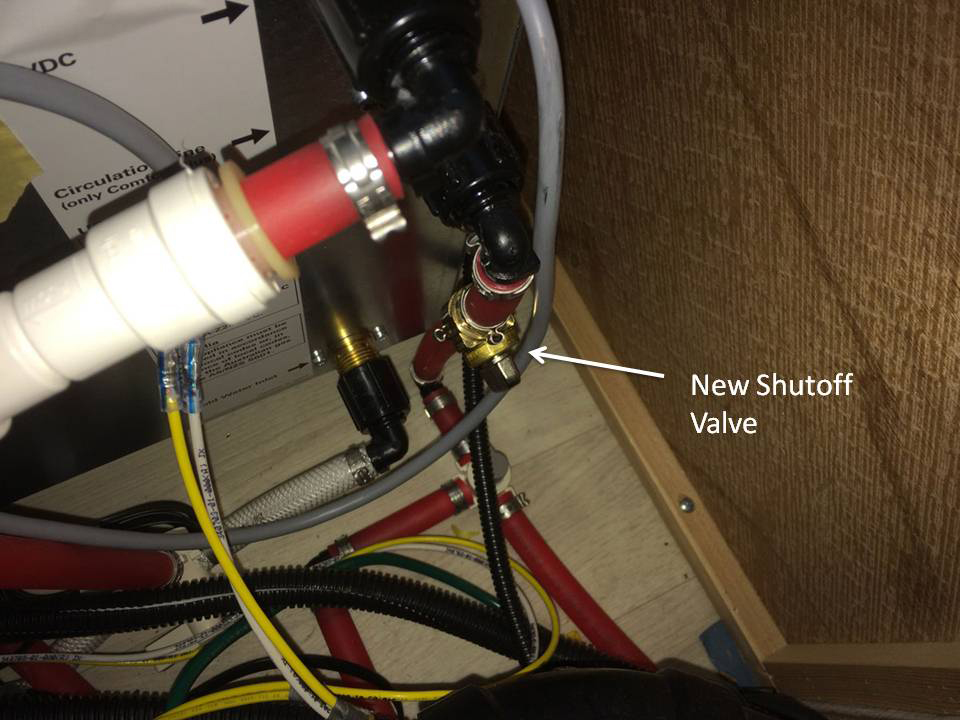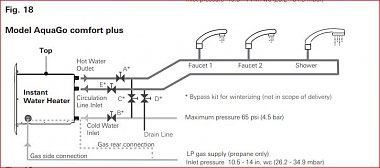Truma RV Water Heater Bypass | RV Mods
During my inaugural winterization of the View using RV anti-freeze fluid, the first sign that things weren’t going well was when the antifreeze jug was emptying at an alarming rate - and I could hear the sounds of a waterfall on the other side of the coach. I turned off the pump and upon turning the corner, could see anti-freeze pouring out from the Truma.
“Not Good”, I thought to myself.
For a rookie Winnebago owner, this was very disconcerting! I shut things down, and came inside to try to figure out what was going on. First I went to the Truma manual; it was not very helpful, as it appears it is missing the diagram that the winterization text references. Next, I went to Winnebago’s neighbour at Lichtsinn RV to see if they had any info. Lots of great stuff there, including the Intel that the hot water tank bypass valve … does not really do that job very well. Lichtsinn explained that they used to close the cold water bypass valve (Valve Number 1), but because it had no effect, they stopped doing that. They leave it open now and allow the Truma to attempt to fill with antifreeze via the cold water intake. Later on in the procedure, when all done pumping antifreeze, they drain the antifreeze from the Truma and remove the filter for the winter.
So why the disconnect between the owner’s manual and what Winnebago’s Nationwide top selling View / Navion dealership recommends? Looking at the system carefully revealed that the legacy Winnebago bypass system might have been continued in production without taking into account the new hot water re-circulation system that was introduced with the addition of the Truma heater. During Winnebago’s winterization process, shutoff / diverter valve Number 1 does indeed close off the cold water line and prevents antifreeze from being supplied to the Truma, the big white check valve in the hot water intake does indeed prevent the anti-freeze from now backfilling into the Truma - and ensures the hot water lines now get filled with the anti-freeze - but they forgot about the hot water re-circulation line that will carry that pink stuff all the way back to the Truma and fill up the reservoir. It is this re-circulation line that is flooding the Truma with anti-freeze and allows the fluid to pour onto your clean driveway if you follow the owner’s manual as written.
What is the fix? Install a shutoff valve in the recirculation line intake to absolutely isolate the Truma from the coach plumbing system.
Is it really needed? Aren’t we just losing some cheap anti-freeze fluid each fall? Well, it depends on how you use your motorhome. If you don’t use the coach in cold weather, you are right. But, if you want to be able to use the coach in sub-zero temperatures – completely isolating the Truma from the coach plumbing system will allow you to carry on without having to purchase the Truma Electric Anti-freeze Kit during situations where you can’t burn propane in the water heater.
Truma Aqua Go Electric Anti-freeze Kit
Hey - I’m NOT saying that this kit isn’t a great idea and doesn’t make for a very convenient way to operate in cold weather. (We have one, and are very happy with the purchase.) This kit is intended to allow the Truma to withstand sub-zero temperatures in situations where you can’t feed propane to the Truma to have it keep itself warm. Situations such as – you are driving through an area of sub-zero temperatures and can’t run the propane, or you run out of propane while camping and the Truma can’t keep itself warm - and will be susceptible to freezing up. This kit is not a substitute for propane in the production of hot water, just a method of preventing the Truma from freezing up when propane is not available. I’m just saying that if you don’t have one, there is an alternative to keeping operational - a shutoff valve in the recirculation line.
With this shutoff valve mod you can totally isolate the Truma from the coach plumbing by draining the water heater completely and continue to use the coach plumbing with cold water only. This might save you when driving in the winter, and are able to keep the coach warm enough during transit to not have to worry too much about coach plumbing freeze up – you still have to worry, but might be Ok for short periods of time. (See the Cold Weather Capability mod for more info on cold weather operations)
Another reason for completely isolating the Truma would be allow you to carry on operations with cold water only, if the Truma was ever to develop a problem. If it wasn’t working correctly, leaking, or you suspected something was not quite right, you could turn it off and then isolate it from the cold water system and carry on. And, as mentioned, the other reason for completely isolating the Truma would be to save a bunch of RV anti-freeze fluid each fall. (When I discussed this issue with Truma, they said that filling the heater with RV fluid is not going to hurt it, AS LONG AS you don’t accidently operate the heater with the RV fluid in there. In that case, all bets are off on the ongoing health of the water heater. Seems to me that just ensuring water is the only thing that gets in the Truma might be a pretty good idea.)
When I talked to Winnebago about the lack of a true heater bypass system, they acknowledged that they refer customers to the Lichtsinn RV winterization videos and said they would look into making the owner’s manual match up with the way the system really works. (Update - Winnebago never did add a recirculation line shutoff valve of their own. Instead they removed the step in subsequent owner’s manuals that had you turn the # 1 Bypass valve, and now don’t bother to bypass the heater at all. As Lichtsinn does, Winnebago just lets the Truma fill up with antifreeze via the cold water intake.)
Installing a shutoff valve in the recirculation line was straightforward - you will need a PEX cutter, PEX crimping tool, PEX crimp rings for 1/2” PEX piping, and a kitchen shutoff valve for 1/2” PEX piping. (Any home store will have these supplies, and with these in your tool box, you will very quickly have the confidence to work with RV plumbing). Here is a link to a shutoff valve that would work just fine:
The job took about 30 minutes to complete.
After that first winter, during my spring opening up, as a test I repeated the winterization process using water instead of RV anti-freeze. I first repeated the Winnebago process and confirmed that the recirculation line was backfilling water into the Truma. When I closed the shutoff valve in the recirculation line and repeated the owner’s manual process, the Truma stayed dry, and confirmed that it can be completely isolated like the owner’s manual originally, incorrectly, assumed would occur.
Here is a shot of all of the components of the system:

Above, you can see the cold water feed shutoff / diverter valve in the centre of the photo (1), the big white in-line check valve in the hot water exhaust (2), and the new shutoff valve in the hot water recirculation line at the extreme right of the photo (3). You can visualize the RV antifreeze moving from left to right in the cold water line on the floor, hitting the cold water feed shutoff / diverter valve (1) and, if closed, being routed up to the hot water line - not being able to go to the water heater because of the white check valve (2) - and being forced to move to the left to feed the hot water faucets. But, as you know, the hot water circulation line brings the fluid back to the Truma and re-enters the heater to get warmed up again. Throwing the new check valve (3) will prevent fluid from entering the Truma from this recirculation line.
Here is a closeup of the new valve installation:

This is the winterization diagram that is missing from our Truma owner’s manual: The valve I installed is valve “E” in this drawing.

I had a great question come in via this website, along the lines of “How does antifreeze actually get into the recirculation line, if this new valve blocks off off the path for the water to exit?” Winnebago’s winterization process takes care of this predicament in our 24J coach. Winnebago has a valve in the recirculation line, upstream of the new shutoff valve, that gets opened as one of the last steps. The pump supplys antifreeze to the line as it pushes out water and vents it overboard underneath the coach. When you have expelled the water and filled the recirculaltion line with antifreeze, you close the Winnebago line drain valve and turn off the pump to wrap things up.
If you’d like to see this information in a video we put on YouTube, have a look here:
This was an easy mod to make, and likely will earn a spot in the All-Star category because of its usefulness.